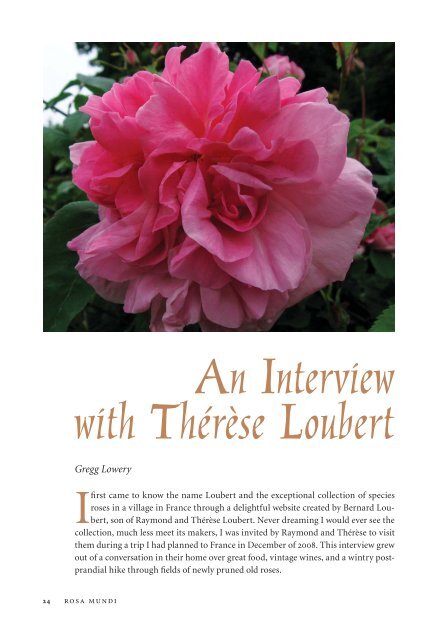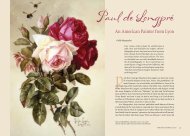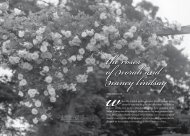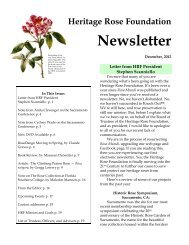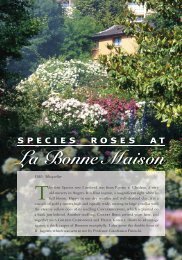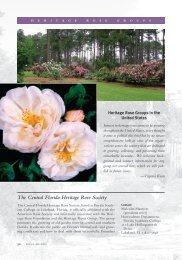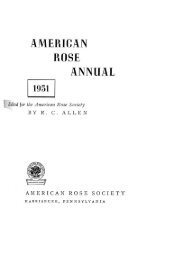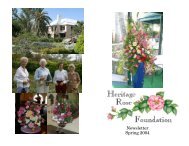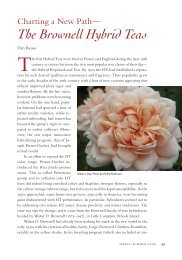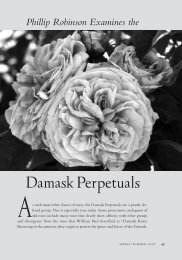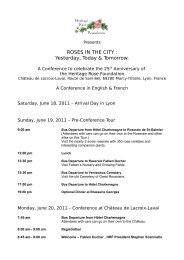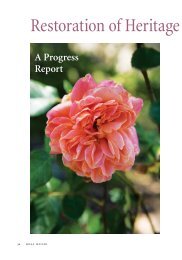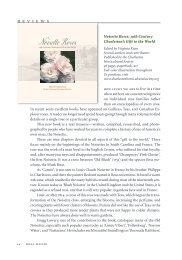An Interview with Thérèse Loubert - Heritage Rose Foundation
An Interview with Thérèse Loubert - Heritage Rose Foundation
An Interview with Thérèse Loubert - Heritage Rose Foundation
You also want an ePaper? Increase the reach of your titles
YUMPU automatically turns print PDFs into web optimized ePapers that Google loves.
<strong>An</strong> <strong>Interview</strong><br />
<strong>with</strong> <strong>Thérèse</strong> <strong>Loubert</strong><br />
Gregg Lowery<br />
I<br />
fi rst came to know the name <strong>Loubert</strong> and the exceptional collection of species<br />
roses in a village in France through a delightful website created by Bernard <strong>Loubert</strong>,<br />
son of Raymond and <strong>Thérèse</strong> <strong>Loubert</strong>. Never dreaming I would ever see the<br />
collection, much less meet its makers, I was invited by Raymond and <strong>Thérèse</strong> to visit<br />
them during a trip I had planned to France in December of 2008. This interview grew<br />
out of a conversation in their home over great food, vintage wines, and a wintry postprandial<br />
hike through fi elds of newly pruned old roses.<br />
24 rosa mundi
In the early years of your nursery you<br />
were growing fruit trees, roses and other<br />
shrubs. How did your collection of mother<br />
plants evolve?<br />
We had a contract nursery and sold plants<br />
to some large nursery houses including<br />
Delbard, Minier, Clause, and other <strong>An</strong>gevine<br />
nurseries. Vilmorin, to whom we<br />
sold as well, had established their nursery<br />
nearby at La Ménitré, and they entrusted<br />
their collection of plants to us.<br />
We were cultivating a good number<br />
of fruit trees, including apples, pears,<br />
peaches, and nectarines, and sold budwood<br />
to tree nurseries. Raymond also<br />
gave them advice on sound growing<br />
practices. <strong>An</strong>d at the time we were also<br />
raising quite a few ornamental shrubs,<br />
including thujas, lilacs, cotoneasters,<br />
and privets—in short, the offerings of a<br />
general nursery.<br />
How did you happen to settle at Les-<br />
Rosiers-sur-Loire?<br />
We moved to Les-Rosiers-sur-Loire in<br />
1963 to be closer to our parents, who<br />
lived in the area. Raymond at the time<br />
was in charge of research in fruit trees<br />
for the Delbard nursery. As we continued<br />
to maintain good relations <strong>with</strong> that<br />
fi rm, we made a decision to strike out on<br />
our own. While planting three hectares<br />
of pear orchard, in the rows between we<br />
added strawberries as a way to see a fi -<br />
nancial return on the land right away.<br />
But it took us ten years to be able fi nally<br />
to live on the production from our own<br />
enterprise.<br />
continued on page 28<br />
CLOCKWISE FROM TOP LEFT: ‘Mme de Sancy de<br />
Parabère’, Rosa omeiensis pteracantha, ‘Gilbert<br />
Nabonnand’ (photos by Étienne Bouret)<br />
spring/summer 2009 25
28 rosa mundi
<strong>An</strong> <strong>Interview</strong> <strong>with</strong> <strong>Thérèse</strong> <strong>Loubert</strong> (continued from page 25)<br />
At what point did you begin collecting roses, and xxx<br />
what roses fi rst caught your attention? How did the xx<br />
collection evolve?<br />
Our rose collection began in 1973 <strong>with</strong> bud wood of<br />
mostly species roses, which came from the rose garden<br />
at l’Haÿ-les-roses and from the Montreal Botanical<br />
Garden, where we had met the curator, Mme Claire<br />
Laberge. Then came roses from the collection at<br />
Sangerhausen and, much closer to us, from la<br />
<strong>Rose</strong>rie de la Beaujoire in Nantes.<br />
Among the fi rst cultivars<br />
were Scots roses, so many of<br />
which are very similar. The<br />
most remarkable rose for me<br />
was Rosa ecae, one of our fi rst<br />
acquisitions, which has survived<br />
the test of time. In<br />
the spring of 2008, we replanted<br />
the entire collection<br />
of species roses in an<br />
effort to avoid the loss of any variety.<br />
Later our dear friend Erich Unmuth<br />
of Austria provided us <strong>with</strong><br />
virtually our entire collection of<br />
the roses of Rudolph Geschwind,<br />
the fi rst rose breeder to approach blue<br />
coloring <strong>with</strong> his mauve roses.<br />
Your collection of historic/antique fruit trees<br />
is impressive. How did this collection start?<br />
Are there still nurseries in France that are<br />
interested in obtaining bud wood from your<br />
tree collection?<br />
TOP LEFT: Rosa latibracteata<br />
BOTTOM LEFT: Rosa hulthemosa × hardii<br />
(photo by Étienne Bouret)<br />
ABOVE: Rosa ecae (from The Genus Rosa by<br />
Ellen Willmott, illustration by Alfred Parsons,<br />
London 1914)<br />
We grow about 250 types of apples both antique<br />
and modern, as well as 70 pear varieties<br />
and 50 cherry cultivars, many of which have suffered in our wet conditions. We also<br />
have a number of apricots, which are also diffi cult to grow well in our area and only<br />
produce fruit one year in fi ve.<br />
Very few fruit tree growers in France are interested in growing antique cultivars,<br />
maintaining that they are not as saleable as the modern, well-known varieties common<br />
spring/summer 2009 29
TOP: Rosa lucens erecta<br />
ABOVE: Rosa fedtschenkoana<br />
TOP RIGHT: <strong>Thérèse</strong> and Raymond <strong>Loubert</strong> standing in<br />
front of ‘Jubilé <strong>Loubert</strong>’<br />
BOTTOM RIGHT: Rosa henryi (photos by Bernard <strong>Loubert</strong>)<br />
30 rosa mundi<br />
today in markets—all too few in<br />
number—like ‘Golden Delicious’,<br />
‘Granny Smith’, ‘Starking’, ‘Pink<br />
Lady’, and ‘Tentation’. Among older<br />
varieties that are still grown locally<br />
here are ‘Reinette du Mans’ and<br />
‘Reinette Grise’. One of our favorite<br />
old pears for fl avor and good storage<br />
is ‘Fondante Thirriot’, a delicious<br />
though small-fruited cultivar.<br />
Could you describe how you grow<br />
your roses and fruit trees and how<br />
the nursery is laid out?<br />
We handle our mother plants just as<br />
we have the plants we grow for sale.<br />
From the fi elds of mother plants<br />
we take bud sticks for grafting new<br />
plants in the nursery. Year after year<br />
we renew part of our mother stock<br />
in order to preserve the diversity of<br />
the collection. Just last summer we<br />
marked a number of varieties that<br />
needed replanting that we were at<br />
risk of losing.<br />
What are some of your favorite<br />
roses?<br />
That’s hard to answer. They’re so different.<br />
The species roses, of course,<br />
including the marvelous Rosa ecae,<br />
and the Moyesii roses, and the superb<br />
Gallicas, and the Tea roses of<br />
Nabonnand, which are so remon-<br />
tant for us and of such delicate coloring . . . in short we love them all.<br />
How did the status of National Collection of Species <strong>Rose</strong>s come to be bestowed on<br />
your collection? Does the collection receive any support from the National Collections<br />
scheme?<br />
The Société d’Horticulture <strong>An</strong>gevine encouraged us to apply for special status <strong>with</strong><br />
the CCVS (the French national plants collections system). After their visit we were<br />
nominated for the National Collection in 2001. We don’t receive any assistance from<br />
the CCVS.
You have belonged to a community of rosarians in France for many years. How has this<br />
enriched your lives?<br />
We’ve had wonderful relations <strong>with</strong> our colleagues in the nursery business, and have<br />
introduced many of their new roses through our offerings, promoting both old and<br />
modern roses.<br />
What was the rose that you introduced that was awarded a prize?<br />
The rose appeared like a gift as a sport in our collection, and coincided <strong>with</strong> our 50th<br />
wedding anniversary. It won a Certifi cate of Merit in 2001 and is called ‘Jubilé <strong>Loubert</strong>’.<br />
Is there any one species rose that you long wanted<br />
to grow in your garden that has eluded you?<br />
One that has not eluded us but that we have lost<br />
is Rosa × hardii. Our climate was simply too cold<br />
and too damp and didn’t suit it.<br />
Gregg Lowery, author of Vintage Gardens Book<br />
of <strong>Rose</strong>s, is vice president of publications for the<br />
<strong>Heritage</strong> <strong>Rose</strong> <strong>Foundation</strong>. He is a garden designer<br />
and is currently working on the design of a new rose<br />
collection and garden for the Albuquerque Botanic<br />
Gardens.<br />
spring/summer 2009 31


